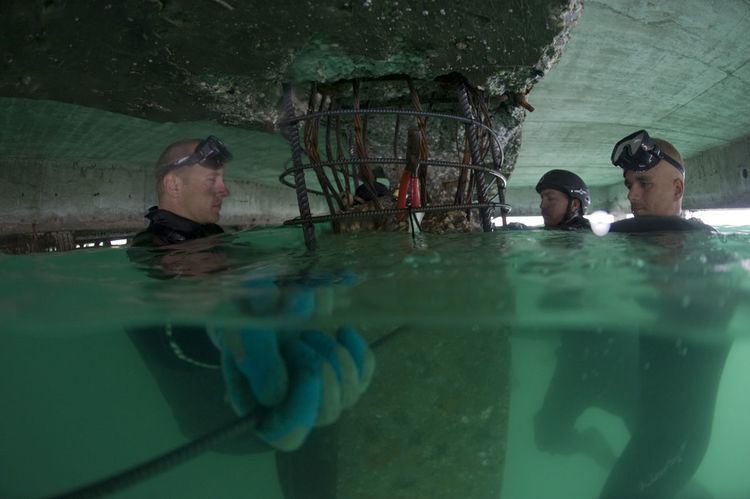 | ||
The Army Engineer Divers are members of the United States Army Corps of Engineers who are trained to undertake reconnaissance, demolition, and salvage tasks underwater. These divers have similar skills and qualifications as professional divers.
Contents
History
Deep sea divers have been a part of the United States Army since the Spanish American War. In 1898, they constructed a cofferdam around the USS Maine to facilitate the ship's inspection and determine the cause of its sinking. Later, during World War I, Army divers built and inspected bridges, tunnels, and port facilities.
As part of the US Army Port Construction and Repair Groups, US Army divers operated throughout the European and Pacific theaters during World War II. Divers performed salvage, demolition, pier construction, and bridging support. As part of the Normandy landings, US Army divers were participated in operations at Utah Beach. They were also employed in rebuilding the port of Cherbourg following its capture. Later they were employed to reopen the Albert Canal from Liège to Antwerp and assisted in the construction of the first Allied railroad bridge across the Rhine River, while in the Philippines they undertook salvage operations in various ports and rivers.
During the Korean War, Army engineer divers worked with Port Construction Companies to build and maintain pipelines in the ports of Inchon and Pohang, and reconstruct the locks in the port of Inchon. Later, during the Vietnam War, Army divers constructed ship-to-shore petroleum distribution and port facilities in Cam Rahn Bay and Qui Nhon; they also constructed ammunitions piers and conducted body, helicopter and vehicle recoveries throughout the theater.
In 1989 during Operation Just Cause, US Army divers from the 536th Engineer Battalion 7th Dive Detachment performed base security at Howard Air Force Base and conducted body recover of MIA pilots and aircraft OH-58 salvage operations in the Panama Canal.
In 1991 during Operation Desert Storm, divers deployed to Kuwait to engage in recovery operations after the ground war, clearing the Kuwaiti port of Shuaibah by removing debris and damaged Kuwaiti and Iraqi boats from the port.
Since then, US Army divers have also supported port opening and reconstruction efforts in military operations in Somalia and Haiti. After 2002, US Army divers have been continuously deployed foreword to the CENTCOM area of operations, including Iraq, Afghanistan, Qatar, Oman, United Arab Emirates, Bahrain, and Jordan. In these areas, Army divers have provided commanders on the battlefield with maneuver support, conducting operations such as search and recovery, river reconnaissance, construction and repair, demolition, salvage, port clearance and security, ships husbandry, and hydrographic surveys.
Army engineer divers continue to represent the vast capabilities of the U.S. Army Engineer Regiment by providing expeditionary engineer diving capabilities in support of combat, general and geo-spatial engineer across the full spectrum of U.S. military operations worldwide. Throughout the history of their employment in the U.S. Army, divers have been organized under various commands and units, ranging from Engineer Port Construction to Transportation Support Commands. Currently, they are organized into five detachments (74th Engineer Dive Detachment, 86th Engineer Dive Detachment, 511th Engineer Dive Detachment, 544th Engineer Dive Detachment, 569th Engineer Dive Detachment) at Joint Base Langley–Eustis, Virginia, and one detachment (7th Engineer Dive Detachment) at Joint Base Pearl Harbor-Hickam, Hawaii. Throughout the various conflicts in which Army divers have been employed, they have trained and fought alongside counterparts from the US Navy. Therefore, the co-location at the Naval Diving and Salvage Training Center is a fitting representation of their intertwined and storied history.
Current duties and notable operations
Army Engineer Divers are trained in underwater construction, salvage, demolitions, hydrographic survey, hyperbaric chamber operation, beach and river recon, bridge recon, underwater cutting and welding, side scan sonar operations, mine and countermine operations, search and recovery operations and ships husbandry operations. Army divers use both surface supplied "Hard hat" and SCUBA to perform their missions.
Port-au-Prince, Haiti, 2010:
The earthquake of January 12, 2010, that left thousands of Haitians dead or homeless and hungry, rocked Haiti’s main port of Port-au-Prince. Shockwaves sent the port’s busy northern pier and its two massive cargo cranes sinking into the sea. The harbor was littered with toppled shipping containers. The southern pier was sheared from its concrete support pilings. The U.S. military worked with Haitian authorities to offload seaborne humanitarian aid and commercial cargo as it helped run the port. At the heart of its plans was an effort to repair the remains of the southern pier, leaving Haiti with a vital avenue for humanitarian aid and commerce.
Training facilities
Qualifications and badges
Badges are awarded according to Humans Resource Command (HRC) and the Diver insignia regulations.
Current equipment
Physical fitness test
Diving medical personnel evaluate the fitness of divers before operations begin and are prepared to handle any emergencies which might arise. They also observe the condition of other support personnel and are alert for signs of fatigue, overexposure, and heat exhaustion.
The test consists of the following carried out in the order given:
- Swim 500 yards (457 m) within 14 minutes. (Candidates are allowed to push off the sides when turning. Only the breaststroke and side stroke are authorized.)
- 10-minute rest period.
- Perform 42 push-ups within 2 minutes (chest touches ground).
- 2-minute rest period.
- Perform 50 sit-ups within 2 minutes.
- 2-minute rest period.
- Perform 6 pull-ups. (Palms away from you. No kipping or swinging is allowed and the chin must clear the top of the bar on each repetition.)
- 10-minute rest period.
- Run 1.5 miles (2.414 km) within 12 minutes 45 seconds.
